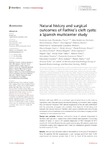Natural history and surgical outcomes of Rathke’s cleft cysts: a spanish multicenter study

Ver/
Use este enlace para citar
http://hdl.handle.net/2183/40993
A non ser que se indique outra cousa, a licenza do ítem descríbese como Creative Commons Attribution 4.0 International License (CC-BY 4.0)
Coleccións
- Investigación (FCS) [1295]
Metadatos
Mostrar o rexistro completo do ítemTítulo
Natural history and surgical outcomes of Rathke’s cleft cysts: a spanish multicenter studyAutor(es)
Data
2024-06-17Cita bibliográfica
Menéndez-Torre EL, Gutiérrez-Hurtado A, Ollero MD, Irigaray A, Martín P, Parra P, González-Molero I, Araujo-Castro M, Idrobo C, Moure MD, Molina AR, Biagetti B, Iglesias P, Paja M, Villar-Taibo R, Pena A, Vicente A, Guerrero-Pérez F, Cordido F, Aulinas A, Mateu M, Soto A. Natural history and surgical outcomes of Rathke’s cleft cysts: a spanish multicenter study. Front. Endocrinol. 2024 Jun 17;5:1413810.
Resumo
[Abstract] Rathke’s cleft cysts (RCC) are a common type of lesion found in the sellar or suprasellar area. They are usually monitored clinically, but in some cases, surgery may be required. However, their natural progression is not yet well understood, and the outcomes of surgery are uncertain. The objective of this study is to evaluate the natural history of Rathke’s cleft cysts in patients who are clinically monitored without treatment, and to determine the outcomes of surgery and the incidence of recurrences over time.
Design and patients: National multicentric study of patients diagnosed of Rathke’s cleft cyst (RCC- Spain) from 2000 onwards and followed in 15 tertiary centers of Spain. A total of 177 patients diagnosed of RCC followed for 67.3 months (6–215) and 88 patients who underwent surgery, (81 patients underwent immediate surgery after diagnosis and 7 later for subsequent growth) followed for 68.8 months (3–235).
Results: The cyst size remained stable or decreased in 73.5% (133) of the patients. Only 44 patients (24.3%) experienced a cyst increase and 9 of them (5.1%) experienced an increase greater than 3 mm. In most of the patients who underwent surgery headaches and visual alterations improved, recurrence was observed in 8 (9.1%) after a median time of 96 months, and no predictors of recurrence were discovered.
Conclusions: Rathke’s cleft cysts without initial compressive symptoms have a low probability of growth, so conservative management is recommended. Patients who undergo transsphenoidal surgery experience rapid clinical improvement, and recurrences are infrequent. However, they can occur after a long period of time, although no predictors of recurrence have been identified.
Palabras chave
Rathke's cleft cyst
Pituitary
Transsphenoidal surgery
Cyst size
Visual impairment
Pituitary
Transsphenoidal surgery
Cyst size
Visual impairment
Versión do editor
Dereitos
Creative Commons Attribution 4.0 International License (CC-BY 4.0)
ISSN
1664-2392






